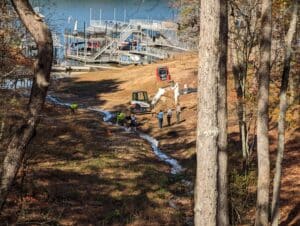Dredging Miller’s Cove –
A Success Story Five Years in the Making

Miller’s Cove was named after an antiquated mill situated next to a small stream that flows into Lake Lanier just off of Buford Dam Rd. near Habersham Marina. The mill was small and likely abandoned by the time the lake came along, but it was still there, as was the stream. And a picturesque place it must have been, hidden in the woods and unencumbered by the trappings of civilization that have mushroomed around the lake in the many decades since it was built. But then development happened – and you know what that means.
The failure of erosion control measures at a housing development uphill from the mill caused a substantial volume of sediment to wash down the slope and into Miller’s Cove. The result was not unlike a myriad of such occurrences that have cumulatively contributed to the siltation of the lake, reducing its water storage and bringing in whatever pollutants stood in the way. It’s an occurrence that’s happened countless times over the last 65 years since the lake first filled, ultimately leading LLA to form its Erosion & Sedimentation Committee to help prevent similar incidents from occurring.
In this case, a conscientious and concerned LLA member contacted the committee, initiating a series of actions that finally came to fruition during the week of Nov. 12: dredging of sediment that entered the lake as a result of the failed erosion controls. Nobody has kept records of this sort of thing, but to our knowledge this is the first time in at least 30 years that a developer has been required to remove such sediment from the lake.

The effort required the support of the Forsyth County Division of Engineering, which required the developer to calculate the volume of sediment that had been discharged and withheld the final certificate of occupancy to ensure the remediation was performed, and the Corps of Engineers, which issued the dredging permit. To its credit, the developer, McKinley Homes, stepped up and contracted for the dredging, with the help of United Consulting.
It took five years to finally bring the initiative to fruition, far longer than we thought it would. And while few lake users may ever notice what was accomplished here, we’d like to think that the effort has established a beachhead for protecting the lake in the future. It is our hope that the Corps will demonstrate leadership in holding developers accountable for illegal sedimentation by requiring them to remove the actual sediment and not just an equivalent volume from a location more accommodating than the impacted site, thereby protecting those who dwell on the lake and use its wonderful resources as Congress intended when it commissioned building Buford Dam back in 1944.



